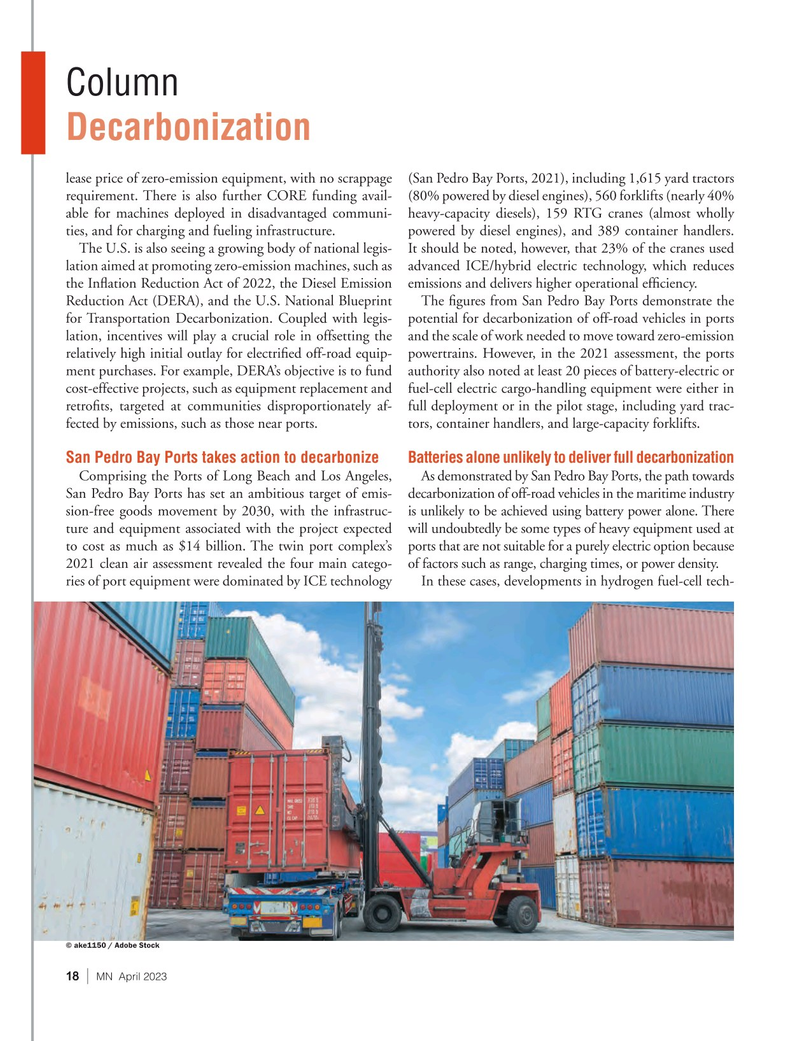
Page 18: of Marine News Magazine (April 2023)
Towboats, Tugs & Barges
Read this page in Pdf, Flash or Html5 edition of April 2023 Marine News Magazine
Column
Decarbonization lease price of zero-emission equipment, with no scrappage (San Pedro Bay Ports, 2021), including 1,615 yard tractors requirement. There is also further CORE funding avail- (80% powered by diesel engines), 560 forklifts (nearly 40% able for machines deployed in disadvantaged communi- heavy-capacity diesels), 159 RTG cranes (almost wholly ties, and for charging and fueling infrastructure. powered by diesel engines), and 389 container handlers.
The U.S. is also seeing a growing body of national legis- It should be noted, however, that 23% of the cranes used lation aimed at promoting zero-emission machines, such as advanced ICE/hybrid electric technology, which reduces the In? ation Reduction Act of 2022, the Diesel Emission emissions and delivers higher operational ef? ciency.
Reduction Act (DERA), and the U.S. National Blueprint The ? gures from San Pedro Bay Ports demonstrate the for Transportation Decarbonization. Coupled with legis- potential for decarbonization of off-road vehicles in ports lation, incentives will play a crucial role in offsetting the and the scale of work needed to move toward zero-emission relatively high initial outlay for electri? ed off-road equip- powertrains. However, in the 2021 assessment, the ports ment purchases. For example, DERA’s objective is to fund authority also noted at least 20 pieces of battery-electric or cost-effective projects, such as equipment replacement and fuel-cell electric cargo-handling equipment were either in retro? ts, targeted at communities disproportionately af- full deployment or in the pilot stage, including yard trac- fected by emissions, such as those near ports. tors, container handlers, and large-capacity forklifts.
San Pedro Bay Ports takes action to decarbonize Batteries alone unlikely to deliver full decarbonization
Comprising the Ports of Long Beach and Los Angeles, As demonstrated by San Pedro Bay Ports, the path towards
San Pedro Bay Ports has set an ambitious target of emis- decarbonization of off-road vehicles in the maritime industry sion-free goods movement by 2030, with the infrastruc- is unlikely to be achieved using battery power alone. There ture and equipment associated with the project expected will undoubtedly be some types of heavy equipment used at to cost as much as $14 billion. The twin port complex’s ports that are not suitable for a purely electric option because 2021 clean air assessment revealed the four main catego- of factors such as range, charging times, or power density.
ries of port equipment were dominated by ICE technology In these cases, developments in hydrogen fuel-cell tech- © ake1150 / Adobe Stock 18 | MN April 2023

 17
17

 19
19
